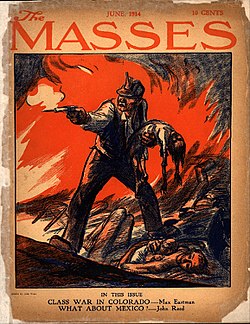The Masses

The Masses was a graphically innovative magazine of socialist politics published monthly in the U.S. from 1911 to 1917, when government suppression shut it down. It was succeeded by The Liberator and then later The New Masses. It published reportage, fiction, poetry and art by the leading radicals of the time such as Max Eastman, John Reed and Floyd Dell.
History
Piet Vlag, an eccentric socialist immigrant from the Netherlands, founded the magazine in 1911. Vlag’s dream of a co-operatively operated magazine never worked well, and after just a few issues he left for Florida. His vision of an illustrated socialist monthly had, however, attracted a circle of young activists in Greenwich Village to The Masses that included visual artists from the Ashcan school like John French Sloan. These Greenwich Village artists and writers asked one of their own, Max Eastman (who was then studying for a doctorate under John Dewey at Columbia), to edit their magazine. John Sloan, Art Young, Louis Untermeyer, and Inez Haynes Gillmore (among others) mailed a terse letter to Eastman in August 1912: “You are elected editor of The Masses. No pay.”[1]
The Masses was to some extent defined by its association with New York’s artistic culture. “The birth of The Masses,” Eastman later wrote, “coincided with the birth of ‘Greenwich Village’ as a self-conscious entity, an American Bohemia or gipsy-minded Latin Quarter, but its relations with that entity were not simple.”[2] The Masses was very much embedded in a specific metropolitan milieu, unlike some other competing socialist periodicals (such as the Appeal to Reason, a populist-inflected 500,000-circulation weekly produced out of Girard, Kansas).
World War I continually exercised The Masses’ political imagination. For The Masses, the cause of the conflict was transparently clear: imperialist international finance capital. Grotesque caricatures of Europe’s wealthy bankers directing workingmen’s guns populated the magazine’s pages. Even before it began, throughout the various scares of 1912 and 1913, the paper consistently railed against militarism. After Eastman assumed leadership, and especially after August 1914, the magazine’s denouncements of the war were frequent and fierce. In the September 1914 edition of his column, “Knowledge and Revolution,” Eastman predicted: “Probably no one will actually be the victor in this gambler’s war—for we may as well call it a gambler’s war. Only so can we indicate its underlying commercial causes, its futility, and yet also the tall spirit in which it is carried off.”[3]
Throughout 1916 and early 1917, in a series of ever more desperate editorials, Eastman, Reed, and the others urged against American intervention in the war. Worried about newly-enacted sedition laws like the Espionage Act of 1917, once the war was declared in April, the paper avoided direct attacks on Woodrow Wilson. More indirect critiques of patriotism, and especially of the draft, were enough to get the magazine charged under the stringent anti-sedition laws. The United States Post Office first denied the magazine second-class mailing privileges. News dealers refused to sell the magazine.[4] Then the editors of The Masses were indicted on charges they had obstructed enlistment.[5] Although a split jury acquitted Eastman and his cohorts, the dramatically higher postal rates were enough to kill the paper on their own.
Notable contributors
Sherwood Anderson
George Bellows
Arthur Davies
Floyd Dell
Max Eastman
Jack London
Amy Lowell
Inez Milholland
John Reed
John French Sloan
Louis Untermeyer
Art Young
See also
Masses Publishing Co. v. Patten
Further reading
- O'Neill, William. Echoes of Revolt: The Masses, 1911-1917. Ivan R. Dee, Publisher. ISBN 0-929587-15-4.
- Zurier, Rebecca. Art for The Masses: A Radical Magazine and Its Graphics, 1911-1917. Temple University Press. ISBN 0-87722-670-9.
External links
Archives
- Cover Illustrations Collection at Michigan State University
- Political Cartoons from the Masses. Marxists Internet Archive. Retrieved on March 11, 2006.
- Max Eastman archive
- John Reed archive
Articles
- The Masses article on Spartacus online encyclopedia. Retrieved on March 11, 2006.
